Photo Essay: Hiking the Volcano Acatenango
read to the end to watch a lightning storm at 12,000 feet
Hi, friends! Two weeks ago, I rolled out a new feature: my monthly salon dinner series, where I give you a themed menu, book/movie recommendations, and an interesting idea to debate, all inspired by a specific place. October’s salon will focus on Guatemala, so to get us in the spirit, I’m sharing an essay about visiting Antigua and hiking a volcano. You can read another essay about my visit to Guatemala here.
This post is full of photos and videos, so your email service may truncate it. If so, click “view in browser” in the top righthand corner of this email, or better yet, join me in the Substack app.
Enjoy, and I’ll see you at the virtual dinner table on October 19!
Sam xx
I think of the cities of the world as falling into one of two categories: those that exploit nature—like Cairo, which drinks so thirstily from the Nile—and those that carry on in spite of it. Antigua Guatemala is one of the latter. Beneath the city, the Earth churns, spits, and swallows itself. Its name, which translates to Old Guatemala, alludes to this precariousness: it was the colonial capital until a series of catastrophic earthquakes forced the Spanish to decamp.
To the north lies the Motagua fault line, where the Caribbean and North American plates collide, and to the west is the Middle Americas Trench, a major subduction zone. Antigua’s lush vegetation, agreeable weather, and cheerfully painted houses belie the volatile plate tectonics below, but its skyline reveals the truth. Active volcanoes loom over the terra cotta rooftops, encircling the city and threatening to raze it at the slightest provocation. Every few blocks is a crumbling colonial church or monastery where hunks of brick and plaster have been left where they fell, bucked off the land like an unbroken horse’s rider. Facades stand without walls behind them, and holes that were once cupolas let in the sun and rain.
As I meandered through Antigua’s ruined courtyards, which stood like shrines to nature’s might, I meditated on humans’ insatiable urge to best nature—to defy it, to harness it—and how in the end, it always wins. This made me question the soundness of my own motives in coming to Antigua. I was there to hike the dormant volcán de Acatenango with my husband, Nick, and my sister-in-law, a project that, as I would soon learn, goes against all reason.
After three days in the city sipping coffee, nibbling dark chocolate, and acclimating to the altitude, we headed into the mountains and huddled with twenty other trekkers near the start of the Acatenango trail. Our guides briefed us on our masochistic endeavor: we would gain 5,000 feet in elevation over just 5 miles, putting us all at risk of sickness; there might be pumas, panthers, and coyotes on the way; we would sleep 12,000 feet up, where it would be freezing although it was summer; and we would wake at 4:00am to scale the last 1,000 feet and watch the sunrise from the top. It would be a grueling two days, but we would be rewarded with a close-up view of the volcán de Fuego, which is famous for its nightly show of magma and billowing smoke.
Cold adrenaline flooded my veins as I realized how flippant I’d been about this. I was poised to embark on the longest, highest hike of my life, only to put myself within striking distance of an active volcano. I sized up my fellow hikers. They were all fit, most not older than 25, and I was certain I would be the weak link. I could already see the epitaph on my Darwin Award: AMERICAN WOMAN, 31, LOSES REAL-LIFE GAME OF “THE FLOOR IS LAVA.” I was about to challenge nature, and surely it would punish me. But I quickly shook that thought, remembering this was a common route. If so many people had done it, why not me?
There was a cemetery at the trailhead—a little gallows humor. And yet, when we started off, my fears seemed unfounded. The path was steep but straightforward, and our group exchanged uplifting travel stories. But then the air thinned, and the conversation with it. The higher we climbed, the more sinister the terrain became. The lush forest that had covered the foot of the mountain dissipated into loose volcanic soil, and the trees that sprung from it were blackened and bare. I began to breathe heavily and my calves quivered. We were ascending quickly—maybe too quickly, I thought, as my head ached from the elevation. The mountain was doing its damndest to beat me back, and when we reached base camp four hours later, I was ready to collapse, but ecstatic at my victory.
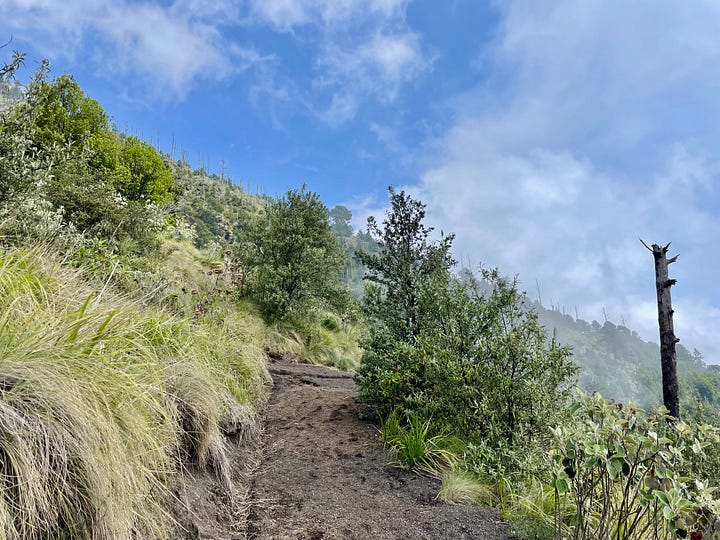
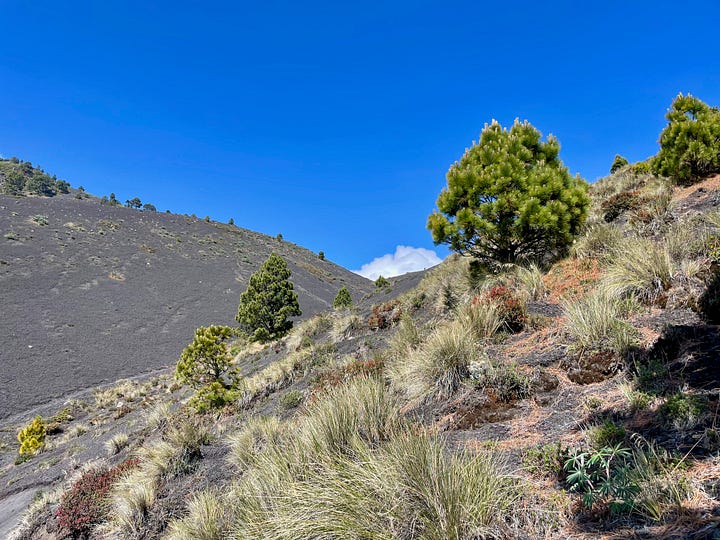
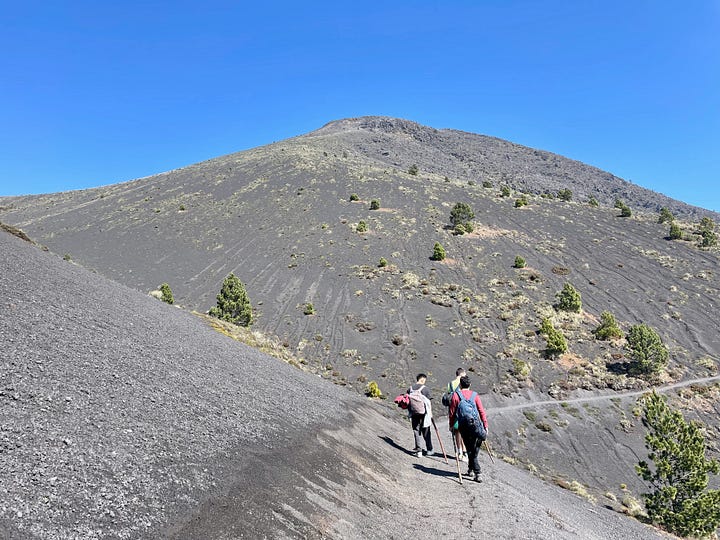
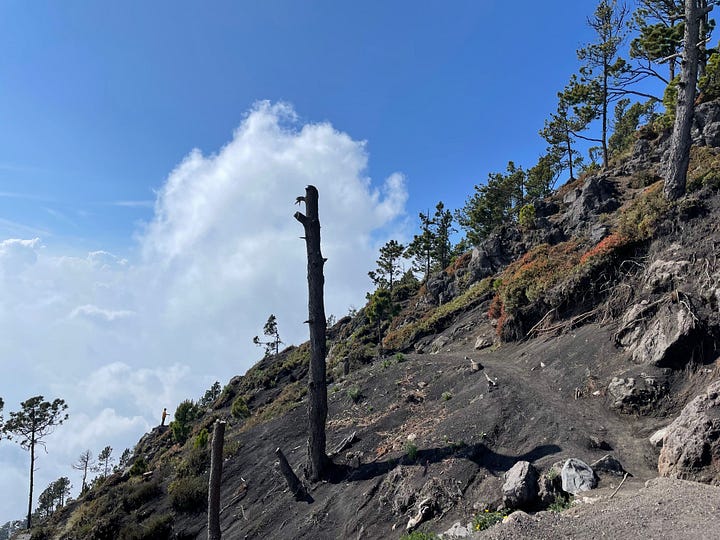
Our home for the night was a metal hut on a ledge, so high it was enshrouded in a frigid veil of clouds. I couldn’t see beyond the drop-off, let alone to the next ridge. Meanwhile, the mountain took its revenge: I had a throbbing pain in my temples, and Nick’s heart, he said, was fluttering too fast—the hallmarks of altitude sickness. But just when it seemed our pain had been for nothing—that we wouldn’t see an eruption, or even the outline of Fuego—the clouds rolled back, revealing the volcano. It was so close we could make out the ash covering its peak.
It was the lift we needed. Fuego glowed in the golden hour, and a reverent hush came over the group. The setting sun was even with the rising moon, as though it were neither day nor night but a liminal time that predated time itself. Then came a soundless, rainless bolt of lightning, then another, and another. As the sky darkened, the flares illuminated the clouds like candlelight through veined alabaster. It was a rarer, more precious gift than a flow of lava, our prize from the mountain for making it this far.
But the trek wasn’t over; we would summit at dawn. I was too ill at ease to sleep that night. I lay awake for hours in a damp, lightheaded trance, desperate for the bathroom yet too cold to leave my sleeping bag. Nick tossed next to me, complaining that his head felt ready to explode. Still, we were determined to try for the summit. Dragging ourselves from bed, we put on our headlamps and started off with the group in the pitch black. The trail was barely wide enough for a single hiker, and one careless step would mean tumbling back to base camp.
The further we climbed, the more my brain felt like jelly. I thought of the earthquake ruins in the town below, and the little voice in my head whispered nature always wins. I knew I shouldn’t be doing this, but oxygen deprivation was contorting my thoughts, and the mountain kept luring me higher and higher. I was so close to dominating Acatenango; how could I possibly give up now?
Then Nick plopped down on a rock, rubbing his forehead. “I can’t do this,” he said. He was too woozy from altitude sickness to go on. I collapsed next to him, silently relieved to have an excuse to stop. “The sunrise will be just as beautiful from camp,” I said. We’d already climbed a volcano and seen an extraordinary storm. Living to tell the tale would be more than enough. With cups of coffee to warm our fingers, we watched a prismatic sunrise hit Fuego from a safe distance. Acatenango had dominated us, but somehow, I felt we’d won.
Our companions returned from the summit having seen no more than we did. Then we made our sore, hobbling descent, and when we reached the bottom, I inhaled the rich air and worshipped the flat ground. The next morning, we packed our bags to leave Antigua, as the Spanish had done three centuries before. As we drove out of town, passing ruin after ruin and leaving the mountains behind, I was grateful that we, like los colonizadores, had the sense to quit while we were ahead.







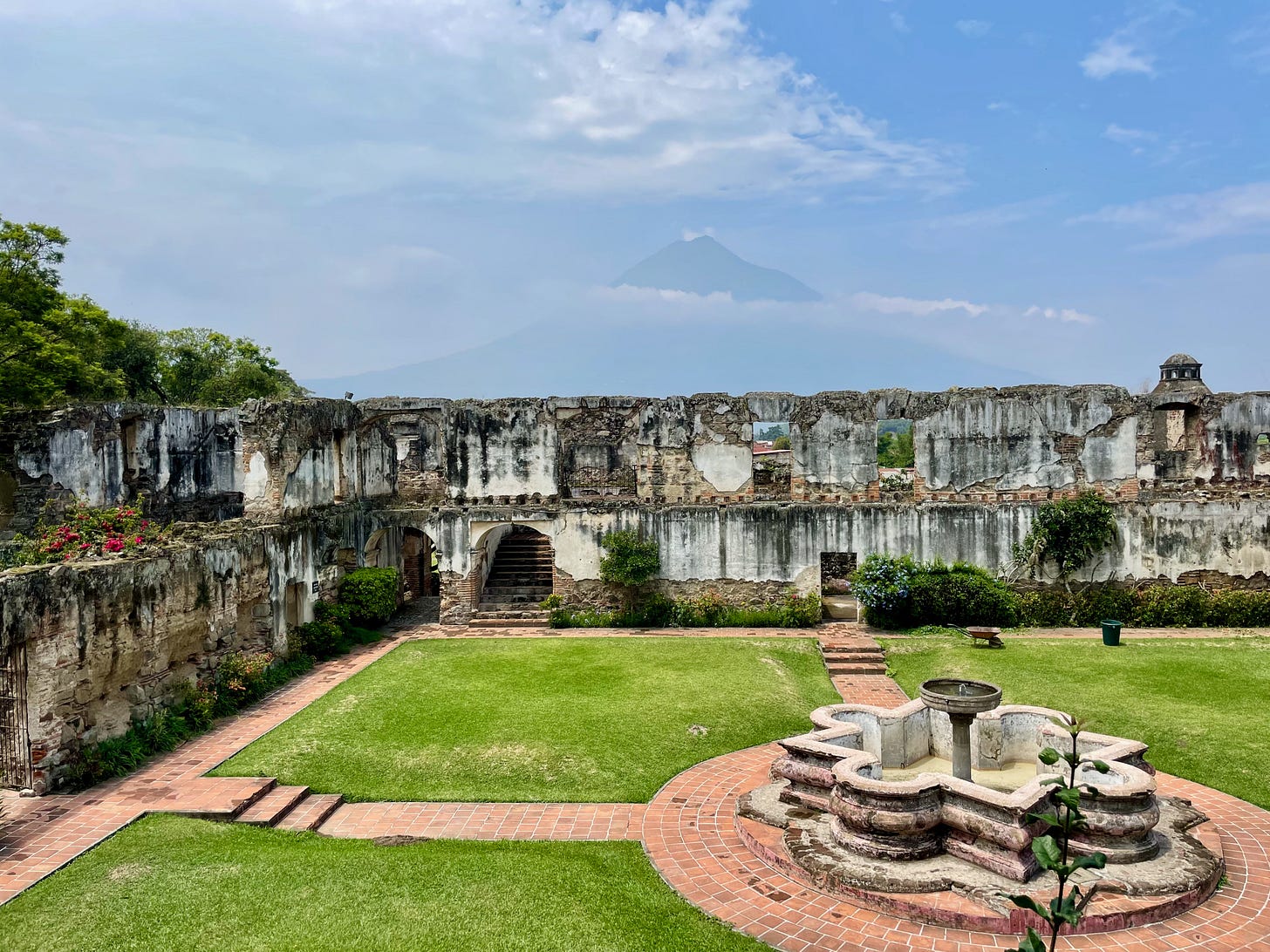
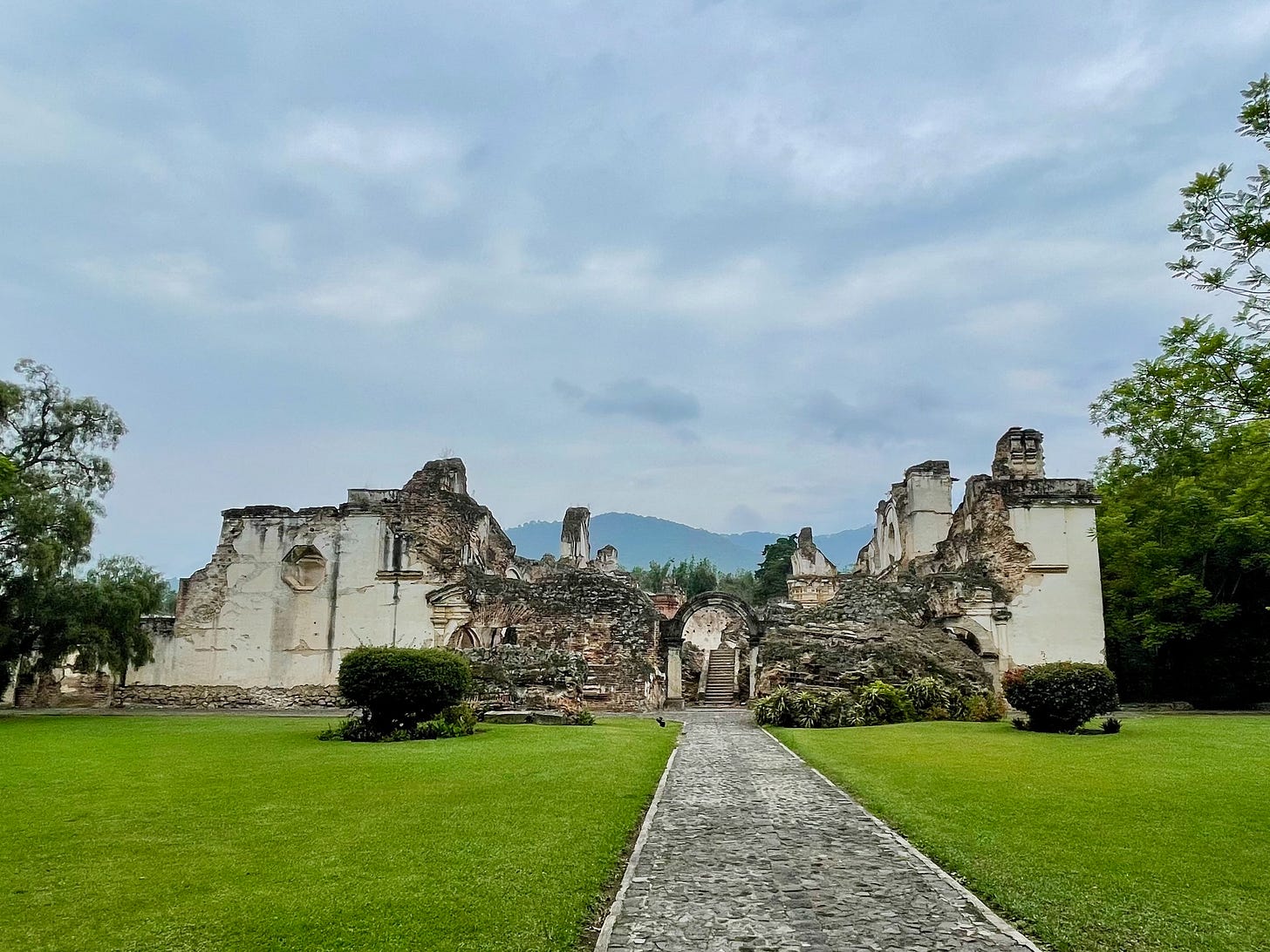
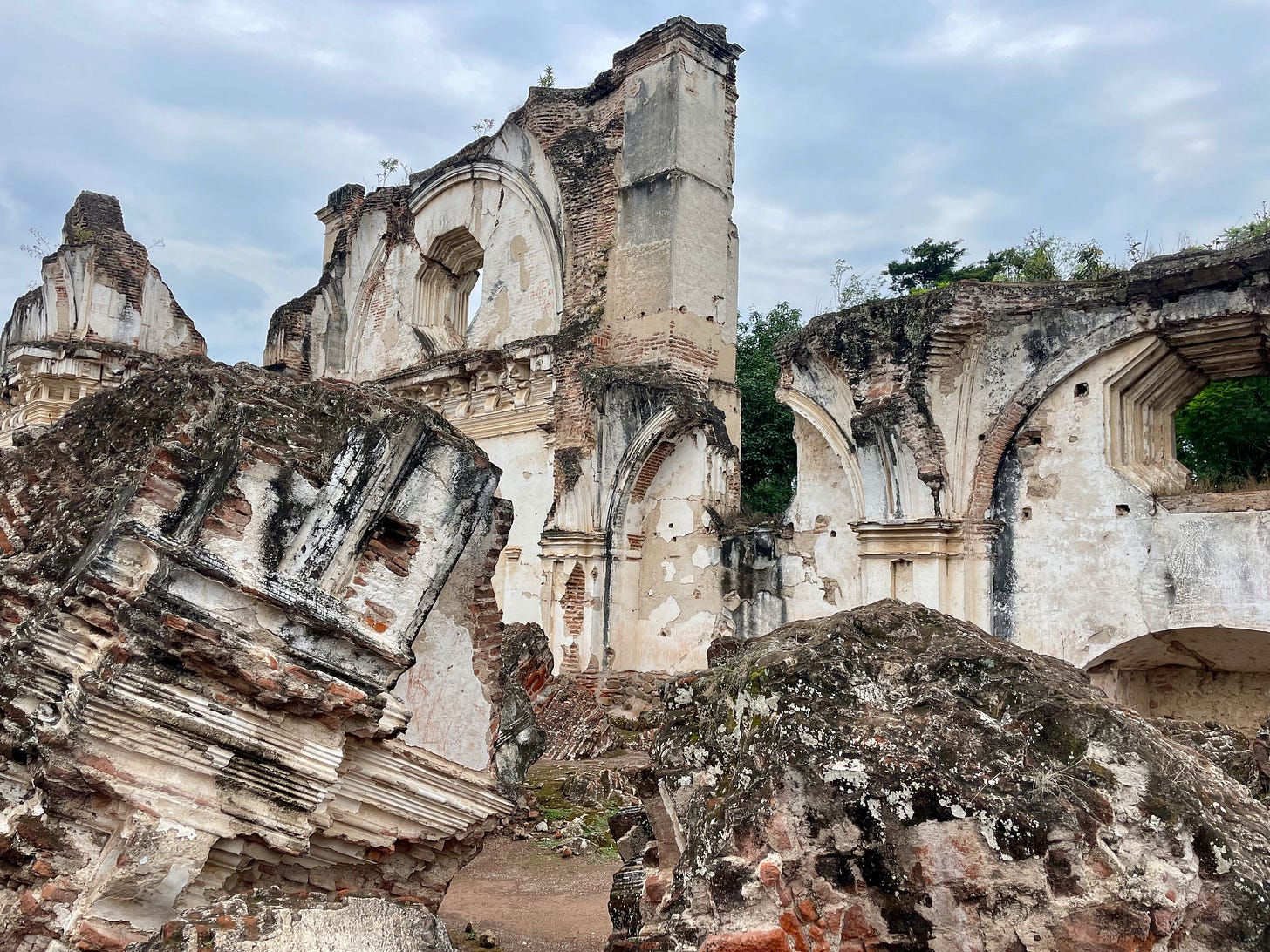




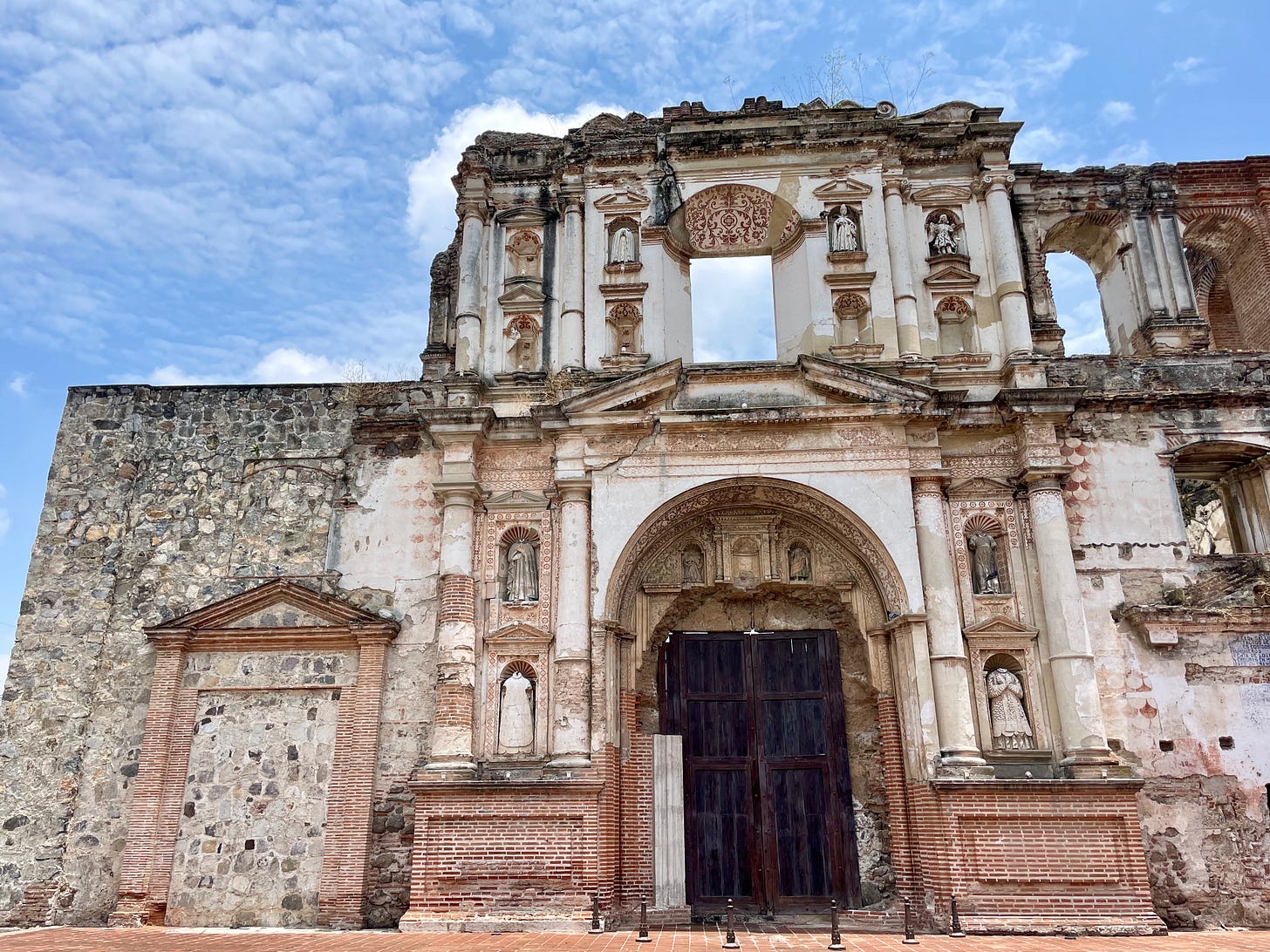
I love Antigua. It also has a lot to say about colonization. Right outside the old-style central area is a restaurant and artist's retreat that is testament to the bubbles you can create. It's a completely different world encompassing only a handful of acres.
I haven't climbed that volcano but I've done the largest one in El Salvador. I want to take that hike. Honestly, having grown up 6000ft in the air that thinner air sounds amazing. Living at sea level is like breathing thru a blanket for me.
You are a brave woman Sam! The mention of the wild animals would have been enough to scare me off. Beautiful photos, as always.